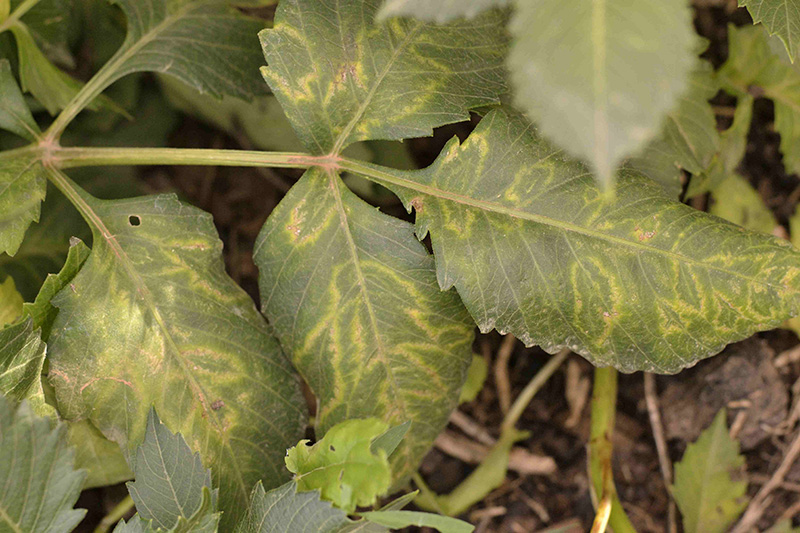It’s a common phenomenon in the plant world—leaves turning yellow. But why does this happen, and what does it mean for the health of your plant? In this blog post, we’ll explore the reasons why Dahlia plant leaves turn yellow and how to address the issue. We’ll also discuss the importance of understanding why this happens in order to care for your plants and keep them healthy properly.

Soil Nutrition
Dahlias thrive in full-sun locations with well-draining, loamy soil that is slightly acidic. To help your dahlias get the nutrients they need, you can top-dress the soil with garden lime and plenty of animal manure while the plants are dormant in the winter. This allows the rain to soak in and provide the nutrients that the dahlias need.
Another common reason for yellowing dahlias is a lack of magnesium or iron in the soil. This can be easily fixed by watering your plants with Epsom salts. Just mix a teaspoon of Epsom salts in a 9-litre can of water and use it to water your dahlias.
This should provide the necessary magnesium to help your plants return to their healthy, vibrant selves.
Root Rot
Root rot is a common problem that can cause dahlias to turn yellow. This occurs when the dahlia is growing in heavy, poorly drained soil that is consistently wet. This type of soil creates the perfect environment for stem rot and tuber rot to occur.
These types of rot are often found in potted dahlias or after a long period of rainy weather. If you notice your dahlia leaves turning yellow and you have not spotted any bugs, it is a good idea to check the tubers to ensure they are not suffering from rot.
In addition to root rot, dahlias can also be affected by verticillium wilt. This is a fungal disease that attacks the stems of the dahlia, causing them to turn black and soft. The leaves of the dahlia will also turn brown, wilted, and withered.
Aphids
If you notice your dahlia plants turning yellow and appearing wilted, it could be a sign that they are being attacked by aphids. These small, sap-sucking insects are common in spring and can quickly spread from plant to plant, causing significant damage. \
In addition to yellowing leaves, aphids can also leave your dahlias vulnerable to mosaic disease, which can further weaken the plant and decrease its chances of survival. It is important to take action as soon as you notice the presence of aphids on your dahlias to prevent further damage and protect the health of your plants.
Fortunately, there are several ways to control aphids on your dahlias. One option is to use a natural method, such as introducing ladybugs or lacewings to your garden, which feed on aphids and can help to keep their population in check.
Alternatively, you can use chemical controls, such as insecticides or pesticides, to kill off the aphids and prevent them from spreading. Whichever method you choose, it is important to be proactive in tackling this issue to ensure that your dahlias remain healthy and vibrant.
Thrips
These tiny insects feed on the juices of plants and flowers, causing damage to the surface and potentially spreading viruses. One of these viruses, known as necrotic spots, causes small spots to form on the leaves that eventually turn into holes. In addition to yellowing, another indication of thrips infestation is silver-colored leaves.
To control thrips, it is important to regularly inspect your plants and remove any visible insects. You can also use insecticides specifically designed to target thrips or introduce natural predators such as lacewings or predatory mites into your garden.
Proper watering and fertilization can also help your plants resist infestation and recover from any damage caused by thrips. This will help you keep your dahlia plants healthy and vibrant in the long run by preventing thrips from doing further damage.
Spider Mites
When left untreated, spider mites damage plants by feeding on sap and may cause yellowing of the leaves, discoloration, and weakening of the plants. It’s important to take action as soon as you notice the presence of spider mites in your garden.
One effective method is to physically remove the mites by rubbing them off with your fingers. You can also use a spray of soapy water or diluted neem oil to help get rid of the mites. Pesticides designed to treat spider mites can also be used, but be mindful of any potential environmental impacts.
For a more environmentally friendly solution, consider introducing beneficial insects like praying mantises, ladybugs, and small spiders to your garden. Just be sure to avoid introducing the harlequin ladybug, which can actually be harmful to your plants.
Dahlia Smut
Dahlia smut is a common problem for dahlia plants, as it causes the leaves to turn yellow and become infected with spores. The fungus Entyloma dahliae is responsible for this disease, which thrives in moist conditions and can easily spread from plant to plant.
The best way to prevent dahlia smut is to improve the overall health of the plant by reducing the density of the canopy, increasing air circulation and light penetration, and minimizing leaf wetness. Additionally, affected plants and leaves should be removed and destroyed, and the use of fungicides can help to prevent further infections.
It is also important to treat stored tubers with fungicidal dust before planting them, as dahlia smut can over-winter in the soil attached to these tubers.
